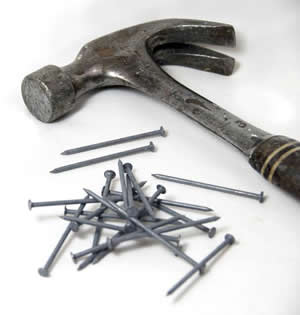“When all you own is a hammer, every problem starts looking like a nail.” Abraham Maslow

Let's Build a Rocket Ship!
It Should be Humiliating . . . For Everyone
What I’m about to discuss will make some of you really mad and some of you really, really happy. I’m not sure whether to point the finger at the trade show industry, manufacturers, distributors, or exhibitors.
Over the years, I’ve written about trade show marketing from multiple angles. I don’t pretend to be an expert. Unlike you, I’m not on the front lines working with clients, nor am I attending a dozen trade shows every year. On the other hand, I have the luxury of seeing your projects and hearing about your orders from you, our designers, and our project managers.
What I’ve learned is that trade show marketing is tough. There are some easy answers, like clear, attractive graphics that address a problem and training your staff how to work a show, but most answers are not so simple. They require in-depth conversations with clients about what they want to achieve, who is their customer base, what is their budget, and what are their overall marketing goals. To get there requires forming a partnership where each side shares information and learns from one another. That takes time and trust.
PJ’s and Dabblers
That said . . . from time to time I run into what I’ll call “Pajama Jockeys” (or PJ’s) in our business. Now, let me qualify this before I get myself into too much trouble. I have no issue with Pajama Jockeys. Their business model works for them. It’s uncomplicated, straight-forward, and often cost-effective for their customers since their low overhead allows them to sell on tighter margins. The same can be said for “Dabblers.” Dabblers are small sign shops that list trade show exhibits in their bag of tricks.
I’ve found that Pajama Jockeys and Dabblers know enough to sell banner stands and basic pop up displays. Occasionally they’ll add Outdoor Displays to their mix. PJ’s are most often home-based businesses with one, perhaps two employees. They have a website, but not a showroom. Nothing gets shipped to them . . . ever! They know their products, and in general, they have satisfied customers. It’s a model that works. Products are sold, customers get what they order, and someone has a job and a business.
That should be enough, right? But it’s not. I’m always surprised when I discover the following: a) They’ve never been to EXHIBITOR (or TS2 when it existed), b) They never attend trade shows, c) They are perplexed by terms like “modular,” “hybrids,” “silicone edge graphics,” and “cam lock construction,” and d) All their products come from one or two suppliers that pull boxes from shelves and print graphics. Their suppliers don’t build anything. And in many cases, don’t attend industry trade shows either because they don’t believe they’re worthwhile.
It’s Either a Profession or It’s Not
Now we’ve all been in this business long enough to know that most clients come to us with little to no knowledge about trade show marketing. Many are going to a show for the first time, or they are replacing someone who used to handle trade shows for the company. Nine times out of ten, the new person may understand marketing, but trade shows are a mystery. These people need guidance. So where do they turn — the web. The web is a glorious thing . . . if you do your research and explore all your options. Too often, we click whatever is on Page One, look at a site or two, and then start the buying process. That’s scary. We all know the path of least resistance is tempting. This site has hundreds of choices, most good, some really expensive. This other site has 25, all at prices that my boss will love.

"Booyah! That's four sales in the last hour."
I’d love to believe that the Pajama Jockey takes the time to consult with their new client. In other words, what are they trying to achieve, what have they done in the past, has it been successful, what’s the budget, etc. But, honestly, when every other customer wants a $99 banner stand or a $599 pop up, you learn not to ask too many questions. It complicates things, and it’s not financially viable or your model. It’s easier to be a clerk than an exhibit consultant in those circumstances.
The Proof is in the Pudding
Just last week, I attended a two-day show in Portland for a regional association. There were perhaps 130 exhibitors, all in 10×10 spaces. On principle, we work through distributors, but our local IT provider asked if we would work with them on a booth for this show. We agreed since they have been good to us over the years. We rented them a VK-1032 (iPhone) after meeting with them several times, reviewing their objectives, making recommendations, and then introducing them to a graphic designer with a background in trade show graphics.
I walked the show on the last day. How can I say this tactfully? I was embarrassed to be in the trade show business. Wobbly banner stands, broken pop ups, vinyl banners hanging from the pipe and drape, and something resembling shelving from Big Lots. Now this wasn’t a local arts and crafts fair or a home improvement show (which are often very creative), but a professional show. What kept crossing my mind was . . . “Did anyone consult with them and advise them of their options. Where did they buy this stuff?” Our client, on the other hand, told me, “We had 10 times the business we’ve ever had.” Why? Because their message was clear, the booth was professional looking, the accessories were appropriate, and they trained their staff.
Now, I’m fully aware that you can lead a horse to water but you can’t make it drink. Some exhibitors are going to make poor decisions based on stubbornness, budget, or stupidity. That’s their prerogative. What worries me is this: Are these new exhibitors getting bad advice or no advice because the tool box they turn to consists of a hammer and nails? They don’t know any better, and the options they are offered are both inadequate and counterproductive.
Which brings me back to my earlier point. Who’s to blame here? I want an easy answer because that would make is simple. But it’s not simple. Yes, I hold PJ’s and Dabblers responsible for clerking rather than consulting, but we’re all culpable when we focus on the transaction rather than the interaction. In our haste to close a sale, we do a disservice to our customer when we fail to behave as exhibit consultants and professionals. That said . . . I know from experience how painful and frustrating it can be to care more about your client’s success than they do. But, that doesn’t excuse us from trying each and every time even if they select a $99 banner stand and a $29 literature holder for their annual industry show.
I’d enjoy hearing your thoughts . . . just count to 10 before hitting the enter button on your keyboard. 😉
— Mel White
http://www.linkedin.com/in/melmwhite
mel@classicexhibits.com
*********************************
Based in Portland, Oregon, Classic Exhibits Inc. designs and manufacturers portable, modular, and custom-hybrid exhibit solutions. Classic Exhibits products are represented by an extensive distributor network in North America and in select International markets. For more information, contact us at 866-652-2100 or www.classicexhibits.com.











